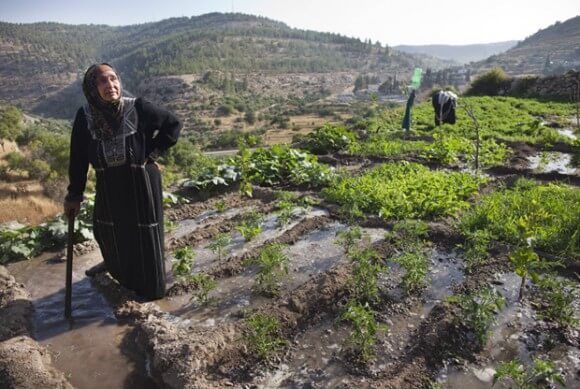Amidst the daily night raids into Palestinian villages across the West Bank and air raids over Gaza, a bit of good news came to Palestine with UNESCO’s vote for Battir as a World Heritage Site. I decided to head down to Battir. I have wanted to go for the last year to explore the green terraces irrigated by an old irrigation system developed during the Roman period.
Thanks to my tiny bladder, I wandered into the village council offices in search of a bathroom before going off to hike in the Battir countryside. I did not know much about Battir, besides the battiri eggplant that is produced on the hillside of the village. The battiri eggplant is long, slender, and sweet. The ladies that I met at the village council office explained that the battiri eggplant is so sweet that you can eat it like a cucumber. I was introduced to the librarian, Miriam, who graciously provided a map and a quick tour of the green terraces and the irrigation system. Miriam explained that there are eight families in Battir and eight days in the week. Each day, one family has access to irrigate its crops with the spring water. Clothing is used to block the irrigation canals in one direction, allowing the water to flow to the fields of the family. Each year, an old measuring stick is placed in the cistern to measure total water collected over the winter. The total water collected is divided equally according to size of land to each of the Battiri families. This is democracy and social justice, I thought. Everyone respects the rules.
Miriam continued to explain that there is zero illiteracy in Battir thanks to Hassan Mustafa. I had never heard of Hassan Mustafa. Miriam explained that each family had a space for the family use. But Hassan Mustafa encouraged each family to convert these family spaces into community centers. One space was converted to the first girls’ school in 1951. Hassan Mustafa was educated and cultured, explained Miriam. He had a college education.
As I continued along my exploration of Battir, I found an elderly fallahee/peasant working on the land. I stopped to talk to him. He was a retired teacher. He mentioned Hassan Mustafa as savior of Battir. The elderly fallahee explained that Hassan Mustafa encouraged the villagers to remain in Battir, despite the fears of the encroaching Jewish aggression. He pointed to a hilltop and explained that the forest was the village of Al Qabu, destroyed by the Zionist aggression. The elderly fallahee pointed down the mountain to the railway showing me that Battir was a strategic location. The train ran from Lod to Battir and finally to Jerusalem. The villagers used the train system to travel. But at one point, the trains stopped running through Battir and the villagers’ mobility was compromised. But Hassan Mustafa lobbyed the UN Relief and Works Agency to build a road connecting Battir to Bethlehem (J. Botmeh, 2006).
I think it is safe to say that Battir would have been gone if it wasn’t for Hassan Mustafa’s efforts. According to research compiled by Jawad Botmeh (2006), the Israelis desperately wanted control of the Battir lands and the railway that ran in the valley. While Battir was never conquered by the Zionists, King Abdallah of Jordan was willing to relinquish Battir to the Israelis. Hassan Mustafa understood the fate of many Palestinian villages, and was determined that Battir would remain. He focused his efforts on lobbying the Jordanians to maintain Battir as well as ensuring that local villagers remained in town working their land. Hassan Mustafa organized young men to patrol the village and maintain constant presence, even when many of the villagers sought safety outside of the village. In a secret meeting on April 18, 1949 between the Israelis and the Jordanians, an agreement was made where the Wallajeh (another Palestinian town) went to the Jews, but Qattanah, Beit Iksa, and Battir were retained for the Palestinians. Even though the Battir lands fell into Jewish territory, the agreement allowed the villagers of Battir to stay in their village and maintain ownership of their lands (J. Botmeh, 2006).
Hassan Mustafa was a leader of his people and saved the village of Battir. My eyes tear as I imagine what would have happened to Battir without a person like Hassan Mustafa. We need more Hassan Mustafa’s today in Palestine.
References
Civil Resistance in Palestine: The village of Battir in 1948 by Jawad Botmeh, Coventry University, September 2006.



Shukran Aisha.
My beloved ‘bathinjaan battiri’ ….. since my childhood, has been a favourite of mine. In the UK the word ‘eggplant’ is never used . Aubergine is.
Thank you Aisha for your beautiful story that awakened my memories and made my mouth water.
The US is indirectly responsible for the state of affairs in Battir: http://www.cnn.com/2014/06/20/travel/unesco-battir-new-world-heritage-site/
Naturally Dick and Jane Taxpayer are totally ignorant of this.
If anyone is interested in reading more about Hassan Mustafa and Battir’s resistance in the 1940, I just discovered that the paper Aisha Mansour cites in this post, “Civil Resistance in Palestine: The village of Battir in 1948,” a Master’s thesis by Jawad Botmeh, is available in full online, in the form of a 47-page PDF, at the following location:
http://www.preparingforpeace.org/pdfpapers/s2-JawadBotmeh.pdf
Thank you for this link, Mr. Norr. I will read it at length later. Hassan Mustafa and Jawad Botmeh do us proud! Too many unsung heroes , sadly.